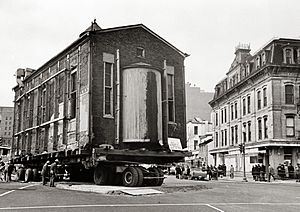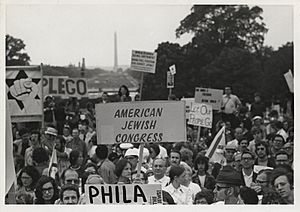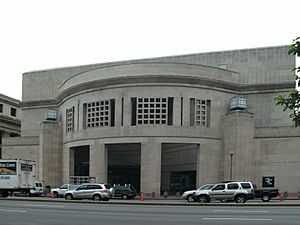History of the Jews in Washington, D.C. facts for kids
The history of Jewish people in Washington, D.C. began in the late 1700s. It continues to grow and change even today. At first, only a few Jewish people lived in the city. Then, more Jewish families moved there in the 1840s, during the American Civil War, and in the late 1800s and early 1900s.
As the Jewish community grew, they built many important places. These include some of the oldest synagogues in the United States. They also worked together during wars and tough times for both the country and Jewish people worldwide. Today, the Jewish community in the Greater Washington area is the third largest in the United States. It is still very active and important in American politics and the wider Jewish world.
Contents
Early Jewish Life in D.C.
The first Jewish person known to live in Washington D.C. was Isaac Polock. He arrived in 1795. He helped build the "Six Buildings" near the White House. These buildings were once home to important government offices and famous people like James Madison.
Major Alfred Mordecai moved to D.C. in 1828. He was a graduate of West Point. His daughter, Rosa, was born in 1839. She is the first known Jewish person born in the District.
More Jewish families came to D.C. in the 1840s. Many were German Jewish immigrants. In 1852, 21 new Jewish residents started the Washington Hebrew Congregation. Captain Jonas Phillips Levy helped this group. He worked with Congress to make sure the congregation could own land. President Franklin Pierce signed this law in 1856. This congregation is the only one with its own special law from Congress. They also opened the first Jewish school in D.C.
How the Civil War Changed the Community
When the Civil War started, Washington D.C. was a key city. It was the Union capital, located between two slave states. The war changed the city a lot. The number of people living there grew very fast. The Jewish population grew ten times, from 200 to 2,000 people. Six new kosher restaurants opened during this time.
The Washington Hebrew Congregation helped Jewish soldiers who were hurt. They also buried Jewish soldiers who had no family to claim them. Women in the congregation raised money for the U.S. Sanitary Commission. In 1864, B'nai B'rith, a Jewish service organization, started a group in D.C. with 28 members.
In 1869, some members left Washington Hebrew. They were unhappy with changes to the services. They started their own group called Adas Israel. When their synagogue was finished in 1876, President Ulysses S. Grant came to its opening.

Many people who came to D.C. during the war decided to stay. By 1880, about 1,500 Jewish people lived there. Seventh Street Northwest became a busy area with many Jewish residents. Other Jewish communities grew in the Southwest and Georgetown areas. They started their own groups and synagogues.
New Immigrants and Community Support
In the late 1800s and early 1900s, many Jewish people moved to the U.S. from Eastern Europe. This brought D.C.'s Jewish population to 4,000. Most of these new immigrants were poor. The D.C. Jewish community created many charity groups to help them. These included a Hebrew Free Loan Society and a Jewish Foster Home.
Other groups started around this time. These included the Hebrew Home for the Aged and the D.C. chapter of the National Council of Jewish Women. There was also a Young Men's Hebrew Association (YMHA) and a Young Women's Hebrew Association (YWHA). Minnie Lansburgh Goldsmith was a key person in helping these charities.
Jewish Life in the 20th Century
During World War I, many soldiers and government workers came to D.C. The Jewish community organized social events for them. These events often took place at the YMHA and YWHA. This led to the creation of the Jewish Community Center (JCC) in 1926. It was located near the White House.
In 1930, the National Jewish Ledger started publishing. It later became Washington Jewish Week. In 1938, the Jewish Community Council was formed. This group worked to support all Jewish organizations in the District.
Zionist groups also started chapters in D.C. These included the Washington Zionist Organization and the Washington Poale Zion Society. After Henrietta Szold visited D.C., a chapter of Hadassah was started in 1919.
Growth During the Great Depression
During the Great Depression, the Jewish community grew very quickly. Its size more than doubled. Jewish people from all over the country came to D.C. to work on New Deal projects. They also found jobs in the growing government. Groups like the Hebrew Sheltering Society helped new arrivals. They provided kosher food, clothing, and housing.
At this time, Jewish families also began to move to suburbs in Maryland and northern D.C. However, some areas had rules that stopped properties from being sold to Jewish people or African Americans. These rules were called "covenants." The U.S. Supreme Court later said these covenants were illegal in 1948.
In the 1930s, Jewish people in Europe faced great danger. The Washington Jewish community worked hard to help them. They signed petitions and held protests. They tried to get the British government to let Jews move to Mandatory Palestine. The first Jewish U.S. Supreme Court Justice, Louis Brandeis, was also active in the Zionist movement.
World War II and Beyond
During World War II, the community helped Jewish newcomers. Many came to work for the government or join the military. In 1941, the JCC helped find homes for 4,000 Jewish people. Community groups also offered social and religious programs for military members. In 1944, the Hebrew Academy opened. It was the first Jewish day school in the area.
After the war, many Jewish community members secretly raised money. This money helped Jewish people illegally move to Mandatory Palestine. It also supported the Haganah, a Jewish defense group. After the State of Israel was created in 1948, local Jewish people bought the first embassy for the new country in D.C.
The Jewish population in the area grew from 20,000 in 1945 to 81,000 in 1956. Half of them lived in the suburbs. By 1970, the population reached 110,000. As people moved to the suburbs, new synagogues and Jewish organizations opened there. Many groups, like the JCC, moved to a central campus in Rockville, Maryland.
Working for Civil Rights
In the 1950s and 1960s, the Jewish community was active in the Civil Rights Movement. The Jewish Community Council supported civil rights. They worked with city and religious leaders to help with peaceful integration after the Brown v. Board of Education decision.
In 1966, young Jewish thinkers started Jews for Urban Justice (JUJ). This group worked against racism towards Black people within the Jewish community. JUJ fought against unfair housing rules. They also organized the first Freedom Seder. This event encouraged friendship between African Americans and Jewish Americans.
In the 1970s and 1980s, many in the community helped Jewish people in the Soviet Union. These Jews were forced to hide their Jewish faith. Many were also denied permission to leave. The D.C. community held large marches on the National Mall. They also kept a daily watch outside the Soviet Embassy. Church groups helped by taking over on Shabbat and Jewish holidays.
When the Jewish population in D.C. started to grow again, the original JCC building was bought back and fixed up. It reopened in the 1990s. In 1997, 165,000 Jewish people lived in Greater Washington. There has also been an effort to save D.C.'s Jewish history. The Jewish Historical Society of Greater Washington opened the Lillian & Albert Small Jewish Museum.
Jewish Life in D.C. Today
Washington, D.C. is home to the United States Holocaust Memorial Museum. This museum teaches about the Holocaust and serves as a national memorial. Congress approved its creation, and it opened in 1993. The National Museum of American Jewish Military History is also in D.C. It tells the story of Jewish Americans who served in the military. Both museums offer free admission.
Today, the Greater Washington area has the third largest Jewish community in the United States. As of 2018[update], about 300,000 Jewish people live in the Washington metropolitan area. About 28,000 of them live in D.C. itself. This is a big increase from 2003, when the population was 215,000.
While D.C. does not have a kosher supermarket, many local grocery stores sell kosher foods. There are also several kosher restaurants certified by the Rabbinical Council of Greater Washington. These include Char-Bar, Soupergirl, and Max's Kosher Cafe. DC Kosher, a project of the Ohev Sholom synagogue, certifies other products and restaurants as kosher.
In 2017, 7% of Jewish adults in the D.C. area identified as LGBT. Also, 7% identified as Jews of color or Hispanic/Latino Jews. About 9% of Jewish homes in the region include a person of color. Most Jewish people of color in the D.C. area live within Washington, D.C.



